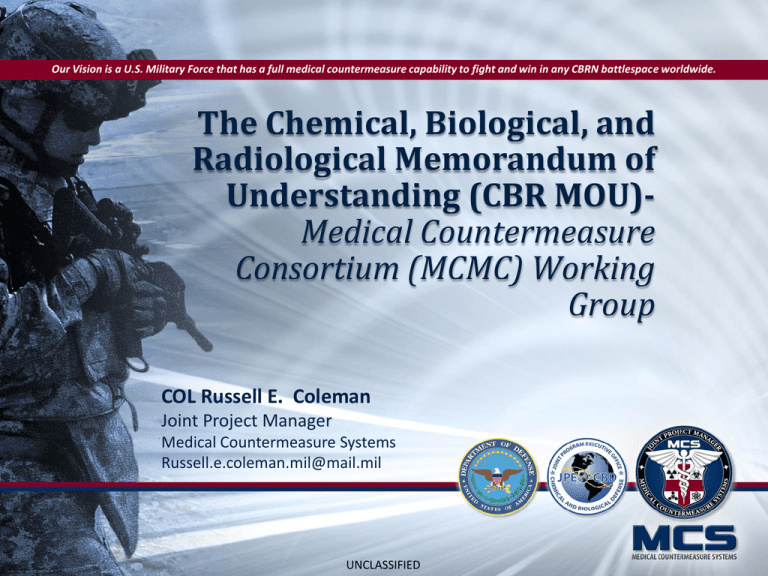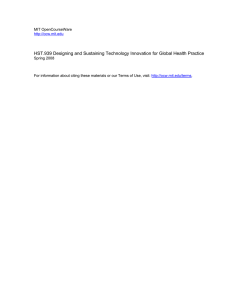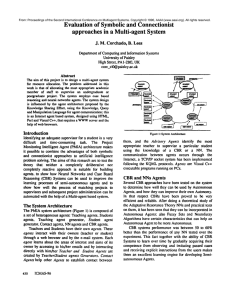Document 13804587
advertisement

Our Vision is a U.S. Military Force that has a full medical countermeasure capability to fight and win in any CBRN battlespace worldwide. The Chemical, Biological, and Radiological Memorandum of Understanding (CBR MOU)Medical Countermeasure Consortium (MCMC) Working Group COL Russell E. Coleman Joint Project Manager Medical Countermeasure Systems Russell.e.coleman.mil@mail.mil UNCLASSIFIED Enhancing International CBR Defense Through Collaboration • The Chemical, Biological, and Radiological Memorandum of Understanding (CBR MOU) is an agreement between Australia, Canada, the UK, and US which: – Serves as a legal vehicle for the establishment of collaborations between foreign governments – Facilitates burden sharing of resources between nations in a constrained fiscal environment – Encourages development of common practices and standardization between international programs, and efforts to achieve program interoperability • CBR MOU Vision: Enable Warfighters to prevent, protect, and respond to global CBR threats in any environment or mission. • CBR MOU Mission: Collaborate to identify, develop, field, and sustain capabilities to prevent and respond to CBR events; protecting our Warfighters and citizens in contemporary and future operating and security environments. Value of the CBR MOU to Industry • The CBR MOU, as a legally recognized agreement, facilitates the sharing of resources (funding, personnel, information, reagents, etc) between the Defense and Public Health departments of the four nations. This benefits industry by: – Increasing funding available for product development – Providing more defined requirements for the development of medical products – Enhancing and diversifying government technical expertise to make more informed product development decisions – Facilitating concurrent regulatory approval of products by the FDA and its foreign equivalents – Reducing the amount of time necessary to identify and attain rare / constrained strains, reagents, or other resources held internationally • Resource sharing can occur through a number of different mechanisms under the CBR MOU – Project Agreements (PA), Cooperative Research and Development Agreements (CRADA), Material Transfer Agreements (MTA), etc. Organization of Efforts Under the CBR MOU •The CBR MOU is divided into four working groups: Assess Inform Protect This provides information regarding the risk and threat from CBR and provides a common four nation view that informs the priorities for collaboration. The ability, whether in terms of military capability or in support to decision makers in the broadest sense, to decide what to do prior to, during or after a CBR event. Affording options to protect people, equipment and infrastructure from the effects of CBR. Lead Nation: US National Lead: Dr. Erik Burnett (SOCOM) Lead Nation: US National Lead: Dr. Eric Moore (DTRA) - Physical Products MedCM Consortium Affording options to protect people, equipment and infrastructure from the effects of CBR. - Medical Products Lead Nation: Lead Nation: US National Lead: US National Lead: Dr. Chuck Bass (DTRA) COL Andrea Stahl (MRMC) CBR MOU Leadership Highest decision-making body; responsible for establishing strategic direction for all CBR MOU activities. US POC: Hon. Andrew Webber Assess Working Group Steering Committee Program Officers, Requirements Officers, Executive Officers and Medical Requirements Officers Inform Working Group Protect Working Group Intermediary committee responsible for interface between strategic and tactical CBR MOU groups. Also, responsible for funding decisions related to MOU work. US PO: Dr. Ben Petro TRLs US MRO: COL Mark Bohannon MCM Consortium The Medical Countermeasure Consortium (MCMC) • Establishes and facilitates collaborations across all technology readiness levels to strengthen our collective preparedness for CBR threat agents, emerging infectious diseases, and pandemic influenza − − − • Utilizes risk and threat analysis to establish essential horizon scanning, discovery science and technology (S&T), and advanced development priorities Emphasis on outcomes with goals to be achieved in a five year time frame; improving the transition of knowledge, technology, and capabilities to the Warfighter Focus on increased effectiveness and efficiency of S&T collaborations while measurably reducing overhead costs. Six priority areas have been identified within the MCMC − − − − − − Antimicrobial Resistance (Task 1) Diagnostics (Task 2) NTAs (Task 3) Filoviruses (Task 4) Bioscavengers (Task 5) Ricin (Task 6) Task 1: Antimicrobial Resistance (AMR) • Purpose: To facilitate collaboration related to the development of MedCMs and supporting technologies targeting AMR bacteria and expedite the delivery of novel medical systems against pathogens of concern. • Program: National interests in and requirements for AMR are diversecollaborative efforts are prioritized by: – National requirements – Portfolio and capability analysis – State of the AMR threat • Scope: Collaborations are organized into 4 overarching areas: – Antimicrobial Target Discovery- S&T – Mechanisms of Resistance / Persistence- S&T – Immunomodulation- S&T / Adv. Dev. – Novel Antimicrobial Approaches- S&T / Adv. Dev. Current AMR Collaborations Fielded System Current Collaboration Technology Readiness Level (TRL) 9 Novel Bacterialdirected therapies 8 7 6 Antimicrobial Target Discovery 5 Immunomodulation 4 Mechanisms of Resistance / Persistence 3 2 Not in current program of work 1 Pathogen- Directed Therapies Host- Directed Therapies Task 2: Point of Care Diagnostics Purpose: Collaborate to develop technologies which enable the earliest diagnosis as fast as possible. Diagnostics are a priority for both defense and public health efforts, especially against priority pathogens and agents of concern. MCMs are most effective when diagnosis is earliest !!! Program: -R&D and validation of rapid clinical diagnostic tools - COTS systems (short horizon) (FilmArray) novel technologies (5-7 yr) - Diagnostic targets (e.g. presymptomatic biomarkers - Bioinformatics : data analysis, management, translation MedCM Diagnosis Prognosis Task 3: Bioscavengers • Purpose: Develop a prophylactic and therapeutic medical countermeasure capable of protecting Warfighters against exposure to a broad spectrum of nerve agents • Program: Collaborate on and invest in emerging and advancing technologies that show promise as prophylaxes and are therapeutic against nerve agent exposure • Scope: To work towards a bioscavenger therapeutic that is: • Protective against a broad spectrum of agents • Useful for pre- and post- exposure scenarios • Administered via IV and/or non-IV route(s) • Manufactured through affordable and scalable processes • Approved by US, UK, CA and EU regulatory bodies Task 4: Filovirus • Purpose: To manage the coordination of Filovirus MCM Development and Supporting Technologies across defense and public health departments of all MOU nations • Program: The US, UK and CA have identified a requirement to develop medical countermeasures (MCMs) to establish force protection against Filoviruses. – – • UK and CA collaboration with the US DoD advanced development programs for Ebola and/or Marburg viruses Coordination of supporting S&T technologies, animal models, and resources such as standardized reagents, challenge materials and assays Scope: Coordination and Integration of S&T, Advanced Development, and Supporting Technologies to mitigate Filovirus. 1. AVI-7288- Therapeutic/PEP for Marburg 2. TKM-100802- Therapeutic/PEP for Ebola TKM-NP-718m siRNA – Therapeutic/PEP for Marburg 3. Favipiravir- Broad Spectrum Therapeutic for Influenza and Ebola 4. Trivalent Filovirus VLP – Vaccine/PEP for Ebola/Marburg 1. Trivalent Filovirus VRP – Vaccine/PEP for Ebola/Marburg 2. Trivalent Filovirus VSV (Profectus rVSVN4CT1)- Vaccine/PEP for Ebola/Marburg 3. ZMapp – Therapeutic/PEP for Ebola Task 5: Non-Traditional Agents (NTAs) • Purpose: To integrate information from, and directions of, Nations’ programs to identify, assess and develop optimal therapeutic strategies for two classes of high priority NTAs. • Program: AUS, CA, US, and UK have identified two classes of NTA as priorities and have active programs investigating MCM and therapeutic strategies for these NTAs • Scope: Coordination of S&T, Advanced Development and supporting technologies to facilitate (for both NTA classes) 1.Characterisation of NTA toxicology • Human toxicity estimates relevant to MedCM • Mechanisms of toxicity and directed medical intervention 2.Assessment of in-service medical interventions • What is the best advice we can give now and in 3 – 5 yrs? 3.Identification of deficiencies in current medical intervention and development of novel or re-purposed MCM • What do we want to do, with what and by when? 4.Identification of triggers to treat (chemical diagnostics) • For therapy initiation and optimal medical management Task 6: Ricin • Purpose: Ricin is readily accessible, can be highly toxic, and there are no approved MCMs or diagnostics for ricin. Task 6 will work to assist each nation to fulfill this capability gap. • Programs: AS, CA, UK, and US have all identified ricin as a high priority agent and all have active, funded, ricin MCM programs. Vaccine Exposure Event Diagnostic/ Detection/ Intel Therapeutic • Scope: Collaboration on the development and licensure of antiricin MCM(s), with concurrent prioritization of animal model development work efforts



